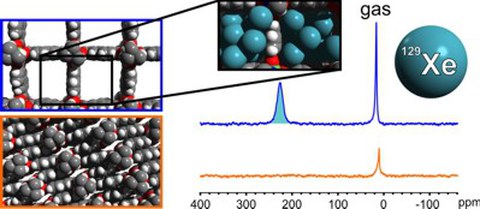NMR an Materialien
NMR-spektroskopische Methoden werden von uns zur Untersuchung von Materialien wie Metallorganischen Gerüstverbindungen (MOFs), von Adsorptionskomplexen (beispielweise der Adsorption von Metallionen an Biopolymeren), sowie zur in situ-Charakterisierung von chemischen Reaktionen in ionischen Flüssigkeiten eingesetzt.
NMR an MOFs (Forschergruppe FOR2433 Schaltbare Metallorganische Gerüstverbindungen)
Metallorganische Gerüstverbindungen (MOFs) sind ein hochaktuelles Forschungsgebiet. Basierend auf einem einfachen modularen Aufbau aus anorganischen Clustern und multifunktionellen organischen Linkern werden mehrdimensionale Netzwerke erzeugt, die spezielle Eigenschaften wie hohe Porosität, große spezifische Oberflächen sowie eine hohe thermische Stabilität aufweisen. Daraus ergeben sich vielfältige Anwendungsmöglichkeiten auf den Gebieten der Gastrennung, Gasreinigung und Gasspeicherung sowie der Katalyse und der definierten Freisetzung von Wirkstoffen.
In situ NMR-Spektroskopie
Die in situ NMR-Spektroskopie eignet sich beispielsweise zur Untersuchung der Gasadsorption in flexiblen MOFs, die den sogenannten gate-pressure-Effekt zeigen. In Abhängigkeit von Druck und Temperatur zeigen diese Verbindungen reversible strukturelle Veränderungen, die zu einer Adsorption und Desorption von Gasen (z.B. Stickstoff, Xenon) in den Poren des MOFs führen.
Mittels einer von uns konstruierten Hochdruckapparatur sind wir in der Lage, den Gasdruck (z.B. Xenon, CO2) im Inneren des NMR-Röhrchens direkt im NMR-Spektrometer zu variieren und Adsorptions-/Desorptionsisothermen und -isobaren aufzunehmen.
Bioinspirierte Materialien
Diatomeen sind einzellige Mikroorganismen, die über eine erstaunliche Kunstfertigkeit bei der Biosynthese von SiO2 (Silica) verfügen. Das Diatomeenbiosilikat zeichnet sich durch hierarchische Muster von nano- bis mikroskaligen Strukturelementen aus, welche dem Material interessante Eigenschaften verleihen, die synthetisch nur schwer zugänglich sind. Es werden Methoden zur Oberflächenabscheidung anorganischer Materialien unter milden Reaktionsbedingungen mit molekulargenetischer Manipulation der Diatomeen-Silica Biogenese kombiniert, um hierarchisch strukturierte, organisch-anorganische Hybridmaterialien mit interessanten katalytischen und optischen Eigenschaften herzustellen. Diatomeenbiosilikat wird uniform mit Enzymen bzw. Edelmetall-Nanopartikeln beladen und dann umfassend im Hinblick auf seine katalytischen Eigenschaften untersucht – besonders hinsichtlich des vermuteten Einflusses der Spezies-spezifischen Silikatstrukturen. Dies wird - zum Verständnis der katalytischen Eigenschaften - von einer umfassenden analytischen Charakterisierung des Biosilikates, besonders seiner Oberflächeneigenschaften begleitet.


